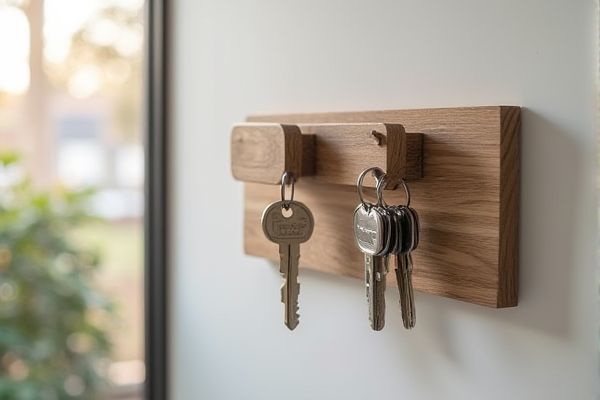
A magnetic key holder offers a sleek, space-saving solution by securely attaching keys to any metal surface, while a tray holder provides a designated spot to collect keys and small items, keeping your entryway organized. Explore the detailed comparison to find the best option tailored for your home organization needs.
Table of Comparison
| Feature | Magnetic Key Holder | Tray Holder |
|---|---|---|
| Function | Holds keys using magnets, allows quick attachment and removal | Provides a flat surface to place keys and small items |
| Material | Usually metal or plastic with embedded magnets | Varies: wood, metal, ceramic, or plastic |
| Placement | Wall-mounted or attached to flat surfaces | Placed on tables, desks, or counters |
| Space-saving | High; utilizes vertical wall space | Moderate; occupies surface area |
| Ease of Access | Instant visibility and easy grab | Keys can be piled, may require searching |
| Organization | Keeps keys neatly separated | Less organized; keys may overlap |
| Installation | Requires mounting hardware | No installation, portable |
| Durability | Durable with sturdy magnets, less prone to wear | Depends on material, prone to scratches or chips |
| Price Range | Moderate to high | Low to moderate |
Introduction to Magnetic Key Holders and Tray Holders
Magnetic key holders utilize strong magnetic strips to securely fasten keys, offering quick access and streamlined organization in both residential and commercial spaces. Tray holders provide a designated surface for placing keys and small items, often designed with compartments to keep belongings neatly separated and easy to locate. Choosing between magnetic key holders and tray holders depends on the need for space efficiency, accessibility, and organizational preferences.
How Magnetic Key Holders Work
Magnetic key holders use powerful magnets embedded within a plastic or metal casing to securely hold keys by attracting the metal parts, ensuring easy access and organization. The magnetic force varies depending on the strength of the magnet, typically neodymium magnets, which provide a strong grip without the need for hooks or clips. Unlike tray holders, magnetic key holders save space and prevent keys from sliding around, making them an efficient solution for home or office key management.
How Tray Key Holders Function
Tray key holders function by providing a designated surface for organizing and storing keys, often featuring compartments or slots to separate different sets. These holders facilitate quick visual identification and easy access, which enhances an efficient key management system. You can keep keys neatly arranged and reduce the risk of losing them compared to other storage methods.
Space Efficiency: Magnetic vs Tray Holders
Magnetic key holders maximize space efficiency by utilizing vertical wall surfaces, thereby freeing up counters and entryway tables. Tray holders require flat surfaces, occupying more horizontal space and potentially contributing to clutter in smaller areas. For compact homes or offices, magnetic holders offer a streamlined solution by consolidating keys without sacrificing valuable surface real estate.
Installation and Setup Comparison
Magnetic key holders offer straightforward installation with adhesive backing or wall-mounted screws, enabling quick setup without tools. Tray holders typically require placing on flat surfaces, needing no installation but occupying counter or desk space. The choice depends on space availability and preference for wall-mounted versus surface-based key storage.
Durability and Longevity: Which Lasts Longer?
Magnetic key holders are typically made from steel or aluminum with strong magnets, offering excellent durability and resistance to wear over time. Tray holders, often constructed from plastic or wood, tend to show signs of wear faster due to surface scratching and potential material degradation. Choosing a magnetic key holder ensures your keys stay secure and the holder maintains its integrity for a longer period, especially in high-traffic or frequently used environments.
Design and Aesthetics Differences
Magnetic key holders often feature sleek, minimalist designs with metallic finishes that seamlessly blend into modern interiors, enhancing visual appeal while providing practical functionality. Tray holders typically offer more variety in materials, such as wood, ceramic, or leather, allowing for a warmer, more decorative aesthetic that complements traditional or rustic spaces. The contrast lies in the magnetic holder's emphasis on clean lines and space-saving utility versus the tray holder's focus on decorative elements and surface area for additional items.
Security and Key Safety Features
Magnetic key holders offer enhanced security by firmly attaching keys to metal surfaces, reducing the risk of accidental drops or misplacement in environments where keys must stay visible but securely in place. Tray holders provide organized storage and easy access but lack the magnetic force to prevent keys from slipping or falling, making them less secure in high-traffic or mobile areas. Security features in magnetic holders often include strong neodymium magnets that ensure keys remain attached even during vibrations or minor impacts, crucial for maintaining key safety in industrial or busy settings.
Maintenance and Cleaning Requirements
Magnetic key holders require minimal maintenance, as their smooth surfaces can be easily wiped down with a damp cloth to remove dust and fingerprints. Tray holders often accumulate dirt and debris in corners, necessitating more frequent cleaning to keep them hygienic and visually appealing. Your choice depends on whether you prefer the low-maintenance convenience of magnetic holders or the broader storage options provided by tray holders.
Choosing the Right Key Holder for Your Needs
Magnetic key holders offer quick and secure access by using strong magnets to hold keys, making them ideal for metal surfaces and spaces requiring easy retrieval. Tray key holders provide organized storage with multiple compartments, perfect for households or offices needing to manage several sets of keys and small items systematically. Selecting the right key holder depends on your preference for convenience versus organization and the environment where you will install it.
 homyna.com
homyna.com